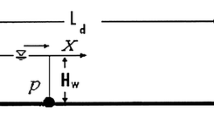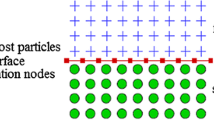Abstract
In this paper, the mesh-less weakly compressible smoothed particle hydrodynamics (WCSPH) method was used to solve the continuity and momentum equations with laminar viscosity and SPS turbulent model. To correct the pressure field and improve the accuracy of the free surface profile, modification of kernel and gradient of kernel was implemented to WCSPH model. The modified method, namely mSPH-T-K, was also equipped with periodic smoothing of the density using the modified kernel. To validate the modified model, the pressure field and wave front position of the 2D dam break flow were compared with those of experimental data, standard SPH method and mSPH-T method, which is the turbulence SPH method without modification of kernel and its gradients. Furthermore, the dam break on a wet bed was performed by the model. The results showed the well agreement of the modified model results of free surface with this benchmark. Finally, transformation of plunging breaker wave on a ramp was modeled with both mSPH-T and modified model. The results showed that the modified model has a good agreement with experimental data.
















Similar content being viewed by others
References
Ketabdari MJ, Nobari MRH, Larmaei MM (2008) Simulation of waves group propagation and breaking in coastal zone using a Navier–Stokes solver with an improved VOF free surface treatment. Appl Ocean Res 30(2):130–143
Monaghan JJ (1994) Simulating free surface flows with SPH. J Comput Phys 110:399–406
Lo EYM, Shao S (2002) Simulation of near-shore solitary wave mechanics by an incompressible SPH method. Appl Ocean Res 24
Khayyer A, Gotoh H, Shao SD (2008) Corrected incompressible SPH method for accurate water surface tracking in breaking waves. Coast Eng 55(3):236–250
Mirmohammadi A, Ketabdari MJ (2011) Numerical simulation of wave scouring beneath marine pipeline using smoothed particle hydrodynamics. Int J Sediment Transp 26(2011):331–342
Crespo AJC, Gomez-Gesteira M, Dalrymple RA (2008) Modeling dam break behavior over a wet bed by a SPH technique. J Waterw Port Coast Ocean Eng 134(6):313–320. doi:10.1061/(ASCE)0733-950X(2008)-134:6(313
Monaghan JJ, Kos A (1999) Solitary waves on a Cretan beach. J Waterw Port Coast Ocean Eng 125(3):145–155
Colagrossi A, Landrini M (2003) Numerical simulation of interfacial flows by smoothed particle hydrodynamics. J Comput Phys 191(2):448–475
Shao S, Gotoh H (2005) Turbulence particle models for tracking free surfaces. J hydraul res 43(3):276–289
Violeau D, Issa R (2007) Numerical modelling of complex turbulent free-surface flows with the SPH method: an overview. Int J Numer Methods Fluids 53(2):277–304
Gotoh H, Shibihara T, Hayashi M (2001) Sub-particle-scale model for the MPS method—Lagrangian flow model for hydraulic engineering. Comput Fluid Dyn J 9(4):247–339
Dalrymple RA, Rogers BD (2006) Numerical modeling of water waves with the SPH method. Coast Eng 53(2–3):141–147
Belytschko T, Krongauz Y, Dolbow J, Gerlach C (1998) On the completness of meshfree particle methods. Int J Numer Methods Eng 43(5):785–819
Monaghan JJ (1992) Smoothed particle hydrodynamics. Annual Rev Astron Appl 30:543–574
Monaghan JJ, Lattanzio JC (1985) A refined method for astrophysical problems. Astron Astrophys 149:135–143
Liu GR, Liu MB (2003) Smoothed particle hydrodynamics: a meshfree particle method. World Scientific
Batchelor GK (1967) Introduction to fluid dynamics. Cambridge Univ. Press, Cambridge
Yoshizawa A (1986) Statistical theory for compressible turbulent shear flows, with the application to subgrid modeling. Phys Fluids 29:2152–2164
Smagorinsky J (1963) General circulation experiments with the primitive equations. Mon Weather Rev 91(3):99–164
Blin L, Hadjadj A, Vervisch L (2003) Large eddy simulation of turbulent flows in reversing systems. J Turbul 4:1
Bonet J, Lok T-SL (1999) Variational and momentum preservation aspects of smoothed particle hydrodynamic formulations. Comput Methods Appl Mech 180:97–115
Dilts GA (1999) Moving-least–squares-particle hydrodynamics—I. Consistency and stability. Int J Numer Methods Eng 44:1115–1155
Bonet J, Kulasegaram S (2000) Correction and stabilization of smoothed particle hydrodynamics methods with applications in metal forming simulations. Int J Numer Methods Eng 47(6):1189–1214
Monaghan JJ (1989) On the problem of penetration in particle methods. J Comput Phys 82(1):1–15
Kiara A (2010) Analysis of the smoothed particle hydrodynamics method for free surface flows
Dalrymple RA, Knio O (2001) SPH modeling of water waves. ASCE
Crespo AJC, Gómez-Gesteira M, Dalrymple RA (2007) Boundary conditions generated by dynamic particles in SPH methods. CMC-TECH SCI PRESS 5(3):173
Martin JC, Moyce WJ (1952) Part IV. An experimental study of the collapse of liquid columns on a rigid horizontal plane. Philos Trans Royal Soc London Series A, Math Phys Sci 244(882):312
Hu CH, Kashiwagi M (2004) A CIP method for numerical simulations of violent free surface flows. J Mar Sci Tech 9(4):143–157
Kleefsman KMT, Fekken G, Veldman AEP, Iwanowski B, Buchner B (2005) A volume of fluid based simulation method for wave impact problems. J Comput Phys 206:363–393
Dean RG, Dalrymple RA (1991) Water wave mechanics for engineers and scientists. World Sci Pub Co Inc
Goda Y, Fukumori T (1972) Laboratory investigation of wave pressures exerted upon vertical and composite walls. Rep Port Harbor Res Inst 11:3–45
Author information
Authors and Affiliations
Corresponding author
Additional information
Technical Editor: Francisco Ricardo Cunha.
Rights and permissions
About this article
Cite this article
Rostami Varnousfaaderani, M., Ketabdari, M.J. Numerical simulation of plunging wave breaker impact by a modified Turbulent WCSPH method. J Braz. Soc. Mech. Sci. Eng. 37, 507–523 (2015). https://doi.org/10.1007/s40430-014-0201-8
Received:
Accepted:
Published:
Issue Date:
DOI: https://doi.org/10.1007/s40430-014-0201-8




